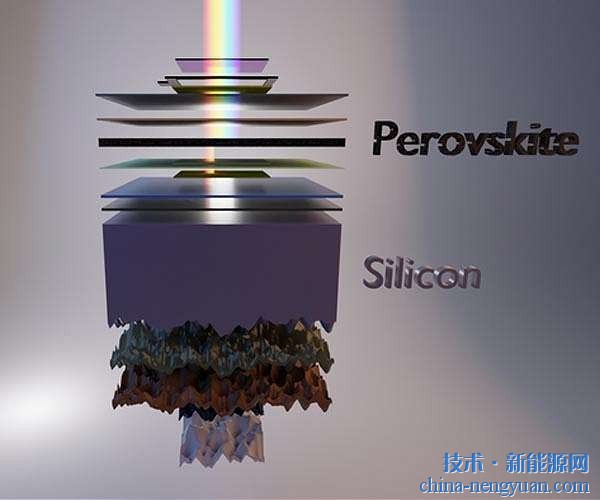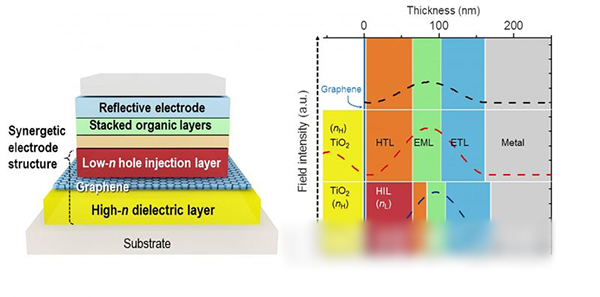 |
The left side is an example made on a glass substrate, and the right two are examples made on a flexible PET substrate.

The laminar structure (left) of the organic EL device and the comparison of the electromagnetic field intensity in the element with other layered structures
A Korean Institute of Science and Technology (KAIST), a graduate school of the Republic of Korea, has developed a green light emitting organic EL device using graphene instead of ITO as a transparent conductive film. The relevant details have been published in the form of papers in the academic journal Nature Communications. This component is intended primarily for display applications.
The external quantum efficiency (EQE) of this light emitting device was as high as 40.8%, and the luminous efficiency felt by the naked eye was as high as 160.3 lm/W. Although organic EL elements using graphene as a transparent electrode have previously appeared in the industry, the elements developed this time are characterized by high EQE and luminous efficiency.
According to KAIST, the reason why the luminous efficiency is high is that a resonator structure is provided for the organic EL element. As a result, the selection effect of a specific wavelength is improved, and at the same time, the loss caused by the surface plasmon on the electrode is also reduced.
The organic EL device developed this time consists of a glass, a titanium oxide (TiO2) layer, a 4-layer graphene, a hole injection layer 1 (HIL1) composed of a conductive polymer, an HIL2, a light emitting layer, an electron transport layer (ETL), Aluminum (Al) electrode and other components.
According to reports, among the structural layers, the key technology is the sandwich design of the TiO2 layer and HIL1 sandwiching four layers of graphene, as well as the thickness and refractive index of each layer. The refractive index of the TiO2 layer is as high as 2.5. Also, the thickness of the layer was designed in such a manner that the light emission was λ and the optical distance was λ/4. This time, the emission wavelength is green (550 nm), so the layer thickness is 55 nm.
HIL1 is composed of "GraHIL" material, which is mixed with PFI (tetra-fluoroethylene-perfluoro-3, 6-dioxa-4-methyl-7-octenesulphonic acid copolymer) in PEDOT:PSS, which is often used as a conductive polymer. ) The polymer. GraHIL has a refractive index of only 1.42. This time, the thickness of HIL1 was designed according to an optical distance of 2λ/3. Incidentally, HIL2 is composed of PEDOT:PSS and has a refractive index of 1.56.
According to the paper, this design uses the following three main purposes. (1) The total optical thickness of the TiO2 layer, graphene, and HIL1 is 3λ/4, which is the same as when the original light extraction efficiency is the highest when the transparent electrode ITO is used; (2) Light emitted by the light emitting layer of the organic EL element is present in the HIL2 and HIL1 When the boundary is reflected, the reflectance increases, and the layered structure from the aluminum electrode of the organic EL element to the HIL2 functions more easily as a resonator; (3) The surface plasmon on the graphene electrode is caused by the low refractive index of HIL1. Loss reduction.
Curved 1000 times with a radius of curvature of 2.3mm, the performance will not be degraded
KAIST produced organic EL elements with almost the same layered structure on PET substrates (rather than glass substrates) and evaluated their luminous efficiency and bending resistance. EQE is several percentage points lower than that produced on a glass substrate, and the luminous efficiency is also lower by about 20 percent. However, these values ​​are much higher than those of a graphene electrode organic EL element that does not use a TiO2 layer or the like.
In terms of bending durability, the performance was not deteriorated after bending tests with a radius of curvature of 2.3 mm at maximum. KAIST states that one of the reasons for the increased bending resistance is that the thickness of the TiO2 layer with low bending resistance is reduced to a very thin level of only 55 nm. (Reporter: Nozawa Tetsuo)
Pipe & Tubes
There are different type of tube and pipe,42mm,48,60mm and so on
Could be Painted,Galavanized,and HDG
Can be use for coupler scaffolding,cup lock scaffolding,Ringlock Scaffolding,Kwistage Scaffolding,Framce scaffolding and so on
Here comes our 5 types of Scaffolding systems:
- Cup lock Scaffolding(C-Lock Scaffolding)
- Ring lock Scaffolding
-Kwistage Scaffolding
-H-frame Scaffolding
-ID15 Scaffolding Tower, this type Scaffolding is the most widely used in construction, such like bridge.
-Whole Aluminum Scaffolding
Pipe & Tubes,Aluminium Pipe Tubes,Pipe And Tubes,Mini Pipe Tubes
HENGSHUI PIONEER IMP & EXP TRADING CO ., LTD , https://www.hspioneer.com